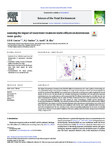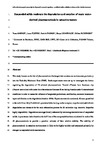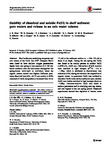Assessing the impact of wastewater treatment works effluent on downstream water quality

Date
2022-11-01Author
Subject
Metadata
Show full item recordAbstract
The impact of wastewater treatment works (WwTW) effluent on downstream river water quality is of increasing concern, particularly owing to the presence in effluents of a range of trace substances. In the case of contamination by metals the question of bioavailability has recently been accounted for in setting water quality standards for several metals. In the UK over the past decade the Chemical Investigations Programme (CIP) has generated upstream and downstream river quality data as well as associated WwTW effluent monitoring for over 600 sites, for the main contaminants of regulatory interest under the Water Framework Directive. Data presented here show that at a local level WwTW discharges have little impact for many contaminants. Soluble reactive phosphorus, hexabromocyclododecane (HBCDD), cypermethrin, perfluorooctanoic acid (PFOA) and perfluorooctane sulfonic acid (PFOS) have been shown to be the principal substances where downstream concentrations were at least 10 % larger than the upstream value. Otherwise, poor compliance with riverine water quality standards tends to be associated with contamination at the river catchment scale, with corresponding implications for the nature of remedial actions that are likely to be successful. Compliance with water quality criteria for metals, taking account of bioavailability, is high overall.
Description
Collections
Publisher
Place of Publication
Journal
Volume
Pagination
Author URL
Number
Recommended, similar items
The following license files are associated with this item:
Related items
Showing items related by title, author, creator and subject.
-
Suspended solids moderate the degradation and sorption of waste water-derived pharmaceuticals in estuarine waters.
Aminot, Y; Fuster, L; Pardon, P; Le Menach, K; Budzinski, H (2018-01-15)This study focuses on the fate of pharmaceuticals discharged into an estuarine environment, particularly into the Turbidity Maximum Zone (TMZ). Batch experiments were set up to investigate the factors regulating the ... -
Stability of dissolved and soluble Fe(II) in shelf sediment pore waters and release to an oxic water column
Klar, JK; Homoky, WB; Statham, PJ; Birchill, AJ; Harris, EL; Woodward, EMS; Silburn, B; Cooper, MJ; James, RH; Connelly, DP; Chever, F; Lichtschlag, A; Graves, C (Springer Science and Business Media LLC, 2017-02-27)Shelf sediments underlying temperate and oxic waters of the Celtic Sea (NW European Shelf) were found to have shallow oxygen penetrations depths from late spring to late summer (2.2-5.8 mm below seafloor) with the shallowest ... -
Uncertainty quantification in shallow water-sediment flows: A stochastic Galerkin shallow water hydro-sediment-morphodynamic model
Li, J; Cao, Z; Borthwick, Alistair (Elsevier BV, 2021-11)All shallow water hydro-sediment-morphodynamic (SHSM) models are prone to uncertainty arising from inadequate representation of the underlying physics and error in input parameters. At the time of writing, most SHSM models ...




